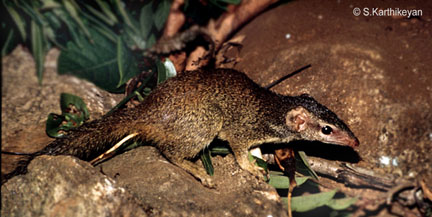Initially thought to be primates (related to monkeys), tree shrews were later classified as rodents (related to mice and rats). And now, on further studies, it has been assigned to a separate order Scandentia.
There are 19 species of tree shrews found in the world, with Borneo alone having ten species! All tree shrews are confined to south and Southeast Asia. Within Indian limits three species are known to occur – two on the mainland and one on the island of Nicobar.
The Indian Tree Shrew also known as the Madras Tree Shrew Anathana ellioti is endemic to India and occurs in peninsular India, south of river Ganges. Within their distribution range, the Indian Tree Shrews are found in forests and on hillsides (at elevations of around 1,400 meters) covered with shrubs and stones.

A small animal, about the size of the striped squirrel, the Indian Tree Shrew measures about 15 inches in total length, with the tail contributing half the total length. On the upper side, the Indian Tree Shrew is rusty-brown while its underside is whitish or buffy. It also has a short, whitish or cream-coloured shoulder stripe.
Very little is known about the habits of the Indian Tree Shrew. It probably lives in much the same way as the other tree shrews. It does not frequent human dwellings like the Common Tree Shrew Tupaia glis. The Indian Tree Shrew is largely silent. However, when it calls, it utters a short squeak repeated a few times in quick succession.
At night, the animals shelter in holes among rocks, sometimes using a system of corridors with two or three entrances. They usually leave the shelters at dawn and return before sunset. Most of their active time is spent finding food–seeking insects on the ground, digging out insects, and occasionally leaping after flying insects. They also eat fruits. They are capable of climbing trees skilfully, but seldom do so and spend most of their time on the ground. They also climb on vertical rocks but never to any great height. They are usually seen to be alone, though occasionally two or three of them can be seen together.
Read more about the Indian Tree Shrew here :
http://thewebsiteofeverything.com/animals/mammals/Scandentia/Tupaiidae/Anathana/Anathana-ellioti.html